

Pearltrees. Power of Nanotechnology – This Video Will Blow Your Mind. Researchers Reveal Smallest, Fastest Nanomotor Yet. Nanotechnology in medicine promises targeted drug delivery while not harming healthy cells.
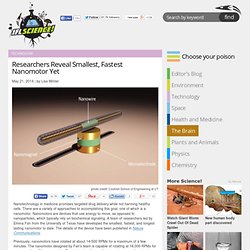
Nanobotmodels Company Offer Vision of Future DNA and Cell-Repair Techniques. Developments in nanotechnology and nanorobotics are opening up the prospects for nanomedicine and regenerative medicine where informatics and DNA computing can become the catalysts enabling health care applications at sub-molecular or atomic scales.
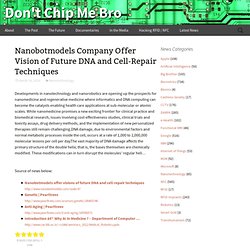
While nanomedicine promises a new exciting frontier for clinical practice and biomedical research, issues involving cost-effectiveness studies, clinical trials and toxicity assays, drug delivery methods, and the implementation of new personalized therapies still remain challenging.DNA damage, due to environmental factors and normal metabolic processes inside the cell, occurs at a rate of 1,000 to 1,000,000 molecular lesions per cell per day.The vast majority of DNA damage affects the primary structure of the double helix; that is, the bases themselves are chemically modified. These modifications can in turn disrupt the molecules’ regular heli… Source of news below: Nanotechnology 2013: Nanotechnology documentary The strange new world of Nanoscience Mega Structures.
NANOTECHNOLOGY: Size DOES Matter. Nano: The Next Dimension. How Nanotechnology Could Reengineer Us - Keithley Instruments Inc. Nanoneural Upgrade. You've always been told that you can "improve your mind" by learning, but a group of European scientists have decided to be more direct about it.
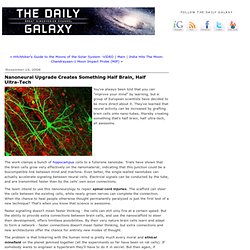
They've learned that neural activity can be increased by grafting brain cells onto nano-tubes, thereby creating something that's half brain, half ultra-tech, all awesome. The work clamps a bunch of hippocampus cells to a fullerene nanotube. Trials have shown that the brain cells grow very effectively on the nanomaterial, indicating that this junction could be a biocompatible link between mind and machine. Even better, the single-walled nanotubes can actually accelerate signaling between neural cells. Electrical signals can be conducted by the tube, and are transmitted faster than by the cells' own axon connections. The team intend to use this nanoneurology to repair spinal cord injuries. Faster signalling doesn't mean faster thinking - the cells can still only fire at a certain speed.
Nanotechnology and DNA Sequencing for Cancer Treatment. Cancer is still Canada’s number one killer.
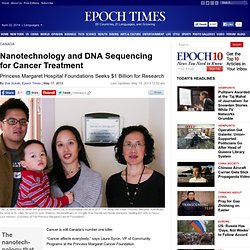
“Cancer affects everybody,” says Laura Syron, VP of Community Programs at the Princess Margaret Cancer Foundation. Repair DNA and Cells using Nanotech. Home > Press > Nanobotmodels Company offer vision of future DNA and cell-repair techniques Abstract: Five decades of research and practical application of computers in biomedicine has given rise to the discipline of medical informatics, which has made many advances in genomic and translational medicine possible.
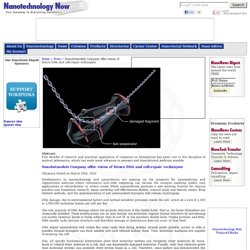
Ukraine | Posted on March 15th, 2010 Developments in nanotechnology and nanorobotics are opening up the prospects for nanomedicine and regenerative medicine where informatics and DNA computing can become the catalysts enabling health care applications at sub-molecular or atomic scales. While nanomedicine promises a new exciting frontier for clinical practice and biomedical research, issues involving cost-effectiveness studies, clinical trials and toxicity assays, drug delivery methods, and the implementation of new personalized therapies still remain challenging. DNA repair nanorobotics will utilize the same tasks that living systems already prove possible.
Nanotechnology takes on cancer. New technology has been forward that claims to be able to directly target cancer cells Nanotechnology has progressed a great deal in recent years and the US National Cancer Institute, (NCI), developed the Alliance for Nanotechnology in Cancer back in 2004. This was in order to bring together the various branches of research, which were being carried out in this field. Interest in this type of research has grown since the formation of the alliance.
There are two areas in which nanotechnology can be applied to cancer. Nanoparticles loaded with bee venom kill HIV. Nanoparticles carrying a toxin found in bee venom can destroy human immunodeficiency virus (HIV) while leaving surrounding cells unharmed, researchers at Washington University School of Medicine in St.

Louis have shown. The finding is an important step toward developing a vaginal gel that may prevent the spread of HIV, the virus that causes AIDS. Fine-tuning Nanotech to Target Cancer. Programmable particle: Bind’s drug-delivery nanoparticle (artist’s rendering).

The results of the human trials are startling. Even at a lower-than-usual dose, multiple lung metastases shrank or even disappeared after one patient received only two-hour-long intravenous infusions of an experimental cancer drug. Another patient saw her cervical tumor reduce by nearly 60 percent after six months of treatment. Though the drug trial—by Bind Biosciences in Cambridge, Massachusetts—of an experimental nanotechnology-based technique was designed simply to show whether the technology is safe, the encouraging results revive hopes that nanomedicine could realize its elusive promise. For more than a decade, researchers have been trying to develop nanoparticles that would deliver drugs more effectively and safely. Nanotech bots can find, kill diseases. Nanotechnology could help fight diabetes: Injectable nanogel can monitor blood-sugar levels, secrete insulin when needed.
Injectable nanoparticles developed at MIT may someday eliminate the need for patients with Type 1 diabetes to constantly monitor their blood-sugar levels and inject themselves with insulin.
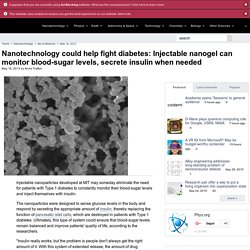
The nanoparticles were designed to sense glucose levels in the body and respond by secreting the appropriate amount of insulin, thereby replacing the function of pancreatic islet cells, which are destroyed in patients with Type 1 diabetes. Ultimately, this type of system could ensure that blood-sugar levels remain balanced and improve patients' quality of life, according to the researchers. "Insulin really works, but the problem is people don't always get the right amount of it. With this system of extended release, the amount of drug secreted is proportional to the needs of the body," says Daniel Anderson, an associate professor of chemical engineering and member of MIT's Koch Institute for Integrative Cancer Research and Institute for Medical Engineering and Science. World's Smallest Ear Can Hear Germs.
A pin dropping is pretty quiet.
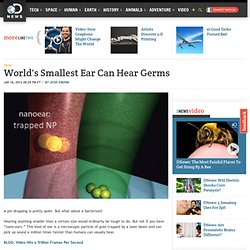
But what about a bacterium? Hearing anything smaller than a certain size would ordinarily be tough to do. But not if you have “nano-ears.” This kind of ear is a microscopic particle of gold trapped by a laser beam and can pick up sound a million times fainter than humans can usually hear. BLOG: Video Hits a Trillion Frames Per Second Sound waves happen when air is compressed and decompressed by pressure waves.
Nanotech tea bag creates safe drinking water instantly, for less than a penny. @LittleDragon: Those devices you mentioned exist, and unless I'm mistaken, they work most of the time.
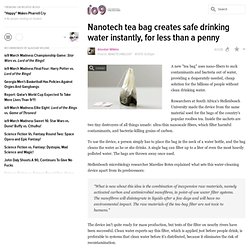
Combining Nanowires and Memristors Could Lead to Brain-like Computing. For decades now, researchers have been trying to get computers to behave like artificial brains instead of merely binary data crunchers. Wax-infused "nanoyarn" used to create artificial muscles. An international team of scientists based at the University of Texas, Dallas (UTD), has developed a new type of artificial muscle created from carbon “nanotubes” – tiny hollow cylinders constructed from the same graphite layers found in the core of a standard pencil. Despite measuring 10,000 times less than the diameter of a human hair, the new muscles can lift more than 100,000 times their own weight, which amounts to approximately 85 times the power of a natural muscle of equivalent size. The new muscles are manufactured by taking a twisted yarn of the miniscule carbon cylinders, then introducing a volume-changing “guest,” in this case the paraffin wax used in candles.
The wax-coated yarn is then heated either electrically, or with a flash of light, and this causes the wax to expand, with the yarn volume increasing, and the length of the material contracting as a result. This muscle contraction, or actuation, can occur in just 25 thousandths of a second. Dr. Source: UTD. Nanostructured nanowires appears to solve loss of superconductivity in very strong magnetic fields. Researchers have discovered a way to efficiently stabilize tiny magnetic vortices that interfere with superconductivity—a problem that has plagued scientists trying to engineer real-world applications for decades. The discovery could remove one of the most significant roadblocks to advances in superconductor technology.
When magnetic fields reach a certain strength, they cause a superconductor to lose its superconductivity.
Nanotechnology_diagram.jpg (902×700) Chem 570 Nanotechnology forTeachers_Page_06.jpg (1506×1121) Welcome to NanoSpace! For Autodesk, a Step Into a Nanoscale World. “Project Cyborg” offers services like molecular modeling and simulation. Autodesk, a quirky software start-up in Marin County, north of San Francisco, rose to prominence in the early 1980s because of AutoCAD, its computer-aided design program that was intended for use on personal computers.
Over the next decade, AutoCAD became the standard design tool for architects and engineers. This week at the TED conference in Long Beach, Calif., the company will take the first public step toward translating its computer design approach, which has since spilled over from Hollywood to the Maker movement, into the emerging nanoscale world of synthetic biology and materials. Nanotech ‘paints’ teeny tiny Mona Lisa. Nanotechnology - Project on Emerging Nanotechnologies. Nanotechnology. Aging is a cellular process, so the only way to stop it (or reverse it) may be on the cellular level. Nano trends. Nanotechnology - Nanosciences. Nanotechnologie. NANOBOTICS. Nanotech. Nanotechnology. Nanotech. Nano. NanoTech_CProduct. Nanowire battery can hold 10 times the charge of existing lithium-ion battery. Stanford Report, December 18, 2007 Courtesy Nature Nanotechnology. Good Vibrations - harvesting energy from sound.
Breakthrough Nanotechnology Will Bring 100 Terabyte 3.5-inch Digital Data... NANOTECH. Nanotech. Nanotechnology Science. Nanotechnology.jpg (1034×776) Scientists observe your body's own self-assembling nanomachines in action. The Most Interesting Developments in Nanotechnologies. Nanotubes boost potential of salinity power as a renewable energy source. In November 2009, Norwegian state owned electricity company Statkraft opened the world’s first osmotic power plant prototype, which generates electricity from the difference in the salt concentration between river water and sea water.
Future looks bright for carbon nanotube solar cells (June 18. Carbon nanotubes. DARPA's Plan to Nanochip Soldiers Has a Darker Agenda Behind it 1/2. Self Assembly Nano Particles for RFID Tag (chemtrails) at NAMI. The singularity is coming: 3 chips that meld man and machine. Nanochip cerebral con wifi: algo impensable hoy, pero que podría sustituir al móvil en el futuro. Sebastian Alvarado's Blog - Nanotechnology as Portrayed in Video Games - The Crysis Nanosuit.